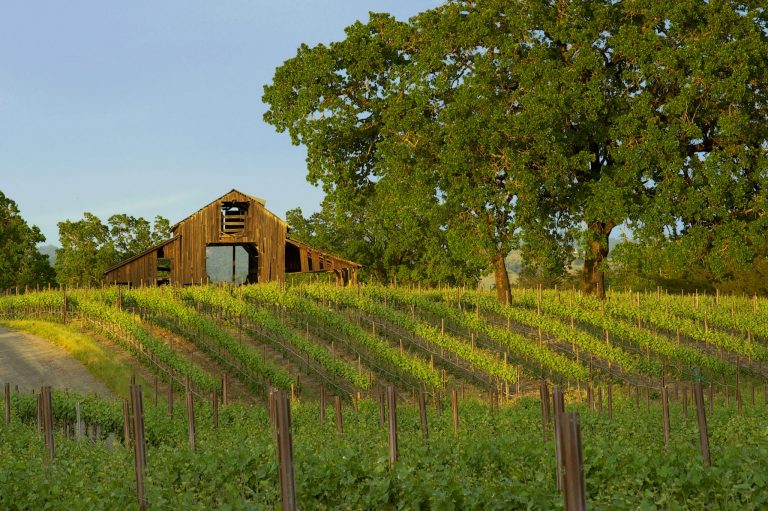A guest post by Henry Trione of Trione Winery
Trione Lineup: The Whites
Trione Vineyards & Winery grows both Sauvignon Blanc and Chardonnay grapes in the Russian River Valley AVA, on the River Road Ranch.

This ranch is right in the middle of the appellation, a prime climate and soil for these cooler climate varietals. The two varietals are distinctly different! From their intrinsic character to the winemaking process, Sauvignon Blanc and Chardonnay each take separate paths to the bottle and on entirely different schedules. To explore the differences, let’s start with their flavor profiles and work our way back to the crush pad.
When someone asks me, “What is your favorite wine varietal?” I reply, “What is the occasion or food pairing?” Applied to the white varietals of the Trione lineup, it is necessary to consider the flavor profiles of the respective wines. In the words of the Trione winemaker, Scot Covington, the River Road Ranch Sauvignon Blanc tastes like the following:
White peaches, nectarines and mandarin zest are the first hints on the nose. The acidity and sweetness on the palate are in perfect balance. This wine is mouth-watering and leaves one craving for fresh oysters, sourdough baguettes, aged gouda, a sandy beach and a setting sun.

I could not have described it better myself, but if I had to define this wine in one word it would be floral. (While also leaving me craving a sandy beach and setting sun, of course!) Sauvignon Blanc is considered an aromatic white grape, light and refreshing with just the right amount of residual sugar to balance the natural acidity. This differs from the richer qualities of Chardonnay and the slight oak flavor imparted from the mixture of new and “neutral” French oak barrels in the winemaking process. In Scot’s eloquent words:
Bottled poetry is the description of the 2017 Trione Chardonnay. Burgundian in style of both nose and palate. Rich and inviting, this wine offers a complex mix of toasty baguette, warm melted brie; silky but with the structure demonstrating the aging potential. The 2017 Chardonnay is tasting great now but will be awesome for the next 5-7 years.

So what do you enjoy these varietals with? The answer is a resounding whatever you like! Personally, Sauvignon Blanc is light and refreshing enough that it can be a stand-alone wine, not requiring any paring to enjoy. The Chardonnay, on the other hand, is a fuller-bodied wine and in my opinion better served with seafood, poultry and lighter pasta dishes. If you want to pair the Trione Sauvignon Blanc with anything in particular, I recommend cheese or oysters. The sweet-tangy characteristics of the wine seem to do these foods justice.
Working backwards, we can see how we arrived at the individual attributes of these varietals, aside from their intrinsic qualities. Unlike the Sauvignon Blanc, the Trione Chardonnay tastes slightly oaky. To achieve this quality, the winemaking process employs the use of 40% new French oak barrels and 60% neutral barrels that have been used in one to two previous vintages already and thus do not impart all that much oak flavor, but still create a softer mouth feel than if it were produced in stainless steel. The oak compliments the grape’s natural hardiness relative to the Sauvignon Blanc grape. So, the winemaking process is quite different, and takes much longer for the Chardonnay. Without getting into the nitty-gritty, the Trione Chardonnay spends 12 months in French oak barrels, while the Sauvignon Blanc is harvested about the same time in the late summer or early fall, and already bottled by April. As Scot mentioned in the quote above, the Chardonnay is suited to age a number of years because of its robustness compared to the Sauvignon Blanc, which in my experience does not benefit from aging. Harvesting the grapes, however, is on a similar schedule. Both Sauvignon Blanc and Chardonnay are considered early-ripening varietals. This is because they do not need as much time on the vine to achieve the appropriate sugar content.
The differences between the two white varietals in the Trione lineup, Sauvignon Blanc and Chardonnay, can be attributed to both nature and nurture. Nature gave the fruit different qualities, and the nurturing of the winemaking process further developed these distinctions. The result is a wine appropriate for different situations. One is light, refreshing and floral, the other is full-bodied, rich and creamy. How you choose to enjoy, is entirely up to your personal taste, and the best way to determine that preference is to experiment for yourself.


